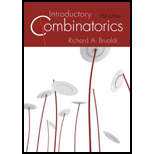Solutions for Introductory Combinatorics
Problem 5E:
Prove that no two integers in Zn, arithmetic mod n, have the same additive inverse. Conclude from...Problem 10E:
Determine which integers in Z12 have multiplicative inverses, and find the multiplicative inverses...Problem 13E:
Let n = 2m + 1 be an odd integer with m ≥ 2. Prove that the multiplicative inverse of m + 1 in Zn is...Problem 14E:
Use the algorithm in Section 10.1 to find the GCD of the following pairs of integers:
12 and 31
24...Problem 15E:
For each of the pairs of integers in Exercise 14, let m denote the first integer and let n denote...Problem 16E:
Apply the algorithm for the GCD in Section 10.1 to 15 and 46, and then use the results to determine...Problem 17E:
Start with the field Z2 and show that x3 + x + 1 cannot be factored in a nontrivial way (into...Problem 21E:
Determine the complementary design of the BIBD with parameters b = v = 7, k = r = 3, λ = 1 in...Problem 24E:
Show that a BIBD, with v varieties whose block size k equals v − 1, does not have a complementary...Problem 25E:
Prove that a BIBD with parameters b, v, k, r, λ has a complementary design if and only if 2 ≤ k ≤ v...Problem 26E:
Let B be a difference set in Zn. Show that, for each integer k in Zn, B + k is also a difference...Problem 28E:
Show that B = {0, 1, 3, 9} is a difference set in Z13, and use this difference set as a starter...Problem 33E:
Let t be a positive integer. Use Theorem 10.3.2 to prove that there exists a Steiner triple system...Problem 34E:
Let t be a positive integer. Prove that, if there exists a Steiner triple system of index 1 having v...Problem 35E:
Assume a Steiner triple system exists with parameters b, v, k, r, λ, where k = 3. Let a be the...Problem 37E:
Prove that, if we interchange the rows of a Latin square in any way and interchange the columns in...Problem 38E:
Use the method in Theorem 10.4.2 with n = 6 and r = 5 to construct a Latin square of order 6.
Problem 39E:
Let n be a positive integer and let r be a nonzero integer in Zn such that the GCD of rand n is not...Problem 40E:
Let n be a positive integer and let r and rʹ be distinct nonzero integers in Zn such that the GOD of...Problem 41E:
Use the method in Theorem 10.4.2 with n = 8 and r = 3 to construct a Latin square of order 8.
Problem 42E:
Construct four MOLS of order 5.
Problem 44E:
Construct two MOLS of order 9.
Problem 46E:
Construct two MOLS of order 8.
Problem 50E:
Let A1 and A2 be MOLS of order m and let B1 and B2 be MOLS of order n Prove that and are MOLS of...Problem 52E:
Construct a completion of the 3-by-6 Latin rectangle
Browse All Chapters of This Textbook
Chapter 1 - What Is Combinatorics?Chapter 2 - Permutations And CombinationsChapter 3 - The Pigeonhole PrincipleChapter 4 - Generating Permutations And CombinationsChapter 5 - The Binomial CoefficientsChapter 6 - The Inclusion-exclusion Principle And ApplicationsChapter 7 - Recurrence Relations And Generating FunctionsChapter 8 - Special Counting SequencesChapter 9 - Systems Of Distinct RepresentativesChapter 10 - Combinatorial Designs
Sample Solutions for this Textbook
We offer sample solutions for Introductory Combinatorics homework problems. See examples below:
To show this, we have to add 3 cases here. Case 1: Assume that one of m and n is even and the second...Procedure used: Multiplication principle: When a task has p outcomes and, no matter what the outcome...Given: The cumulative number of games played on the first n days is denoted by an, where n=1,2,…,77....Algorithm used: Begin with 1←,2←,⋯,n←. While there exists a mobile integer, do the following: (1)...Formula used: The pascal’s triangle formula is: (nk)=n!k!(n−k)!=n(n−1)⋅⋅⋅(n−k+1)k(k−1)⋅⋅⋅1...Suppose the set S={1,2,...,104}. Let A, B, C be the set of integers S that are divisible by 4, 5, 6...Using the mathematical induction and the Fibonacci recurrence. The sequence of numbers...Chapter 8, Problem 1EDefinition used: Let Y be a finite set and A=(A1,A2,…,An) be a family of n subsets of Y. A family...
Definition used: “Let n be a positive integer with n≥2, then Zn={0,1,…,n−1}.” “For any two integers...Definition used: “Two general graphs G=(V,E) and G=(V′,E′) are called isomorphic, provided that...Definition used: Chromatic number: Let G=(V,E) be a graph. A vertex coloring of G is an assignment...The given permutations are, f=(123456642153) and g=(123456356241). Here, (f∘g)(1)=2, (f∘g)(2)=5,...
More Editions of This Book
Corresponding editions of this textbook are also available below:
Related Math Textbooks with Solutions
Still sussing out bartleby
Check out a sample textbook solution.
